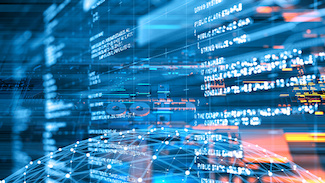The speed of change is hard to fathom. Every day, we make thousands of decisions, ranging from what to eat to what to watch to how to invest our savings. In making these decisions, we contribute to an ever-growing stream of data. Businesses tap into that data as much as possible, using it to shape their products and services and to foresee their customers' demands. In the past, slower data collection and processing techniques have relegated this practice to one of two spheres: businesses either examined the past or speculated about the future. But real-time data analytics allow organizations to do more, and to do it immediately. By interacting with and affecting the market in real time, they are changing the business environment of the present.
To understand the possibilities and advantages that real-time data analytics can offer your organization, it is useful to look at the different types of data processing operations and the various ways we analyze that data.
Three Speeds of Data Processing
The first and slowest form of data processing is batch processing. Batch processing is used to execute a series of non-interactive jobs all at one time. The term takes its name from the days when users entered programs on punch cards. They would give a batch of these cards to the systems operator, who would enter them all into the computer at once. In modern usage, data is gathered, typically over a period of time. Then it is processed on a set schedule and released in its usable form.One example of batch processing is credit card billing. Rather than receive separate bills each time the card is used, customers receive a monthly bill for all purchases within the billing cycle. Batch processing may also be used for other payroll or billing activities, processes that do not typically require fast intelligence or immediate decision-making.
The second processing type is near-time or near-real-time processing. As the name implies, this form of data processing is fast, but not instantaneous, with results ranging from a couple of seconds to a couple of minutes. Some examples of near-time processing include message apps, which may take a few seconds to process and post new messages. Background processes on platforms like social media sites often perform at near-real time. These background processes might evaluate a post, for example, and remove it a minute or two later if it violates the site's policies. This brings us to real-time processing. Real-time processing operates through a continual series of queries; these queries, in turn, require constant processing and produce a steady output of data results. Real-time processing is critical in situations like ATM withdrawals, automated market transactions, data streaming, radar services and other customer service systems.Historical Analytics Versus Real-time Analytics
As the name implies, historical analytics give organizations insights into past events. Analysts choose relevant data from the prior quarter, month or day, and then perform at least one of these three types of analyses: Descriptive Analytics Descriptive Analytics seeks to condense the historical data into a manageable and useful narrative. So, statements such as ''Sales improved 15 percent last quarter'' or ''customers reported a 20 percent increase in user satisfaction for the month of November'' fall into the category of descriptive analytics. Descriptive analytics are used to frame the overall substance of an event and, in turn, can be used to build predictive and prescriptive analytic models. Predictive Analytics Predictive Analytics uses historical data to locate trends and patterns and to predict likely behavior or future scenarios. Some examples of predictive analytics include customized marketing recommendations based on past purchases or searches. Amazon has leveraged predictive analytic strategies to provide customers with further product options based on their shopping history. Prescriptive Analytics Prescriptive analytics attempt to use data sets to provide recommendations about actions and changes. Whereas descriptive analytics tries to describe what was, and predictive analytics help us imagine what will happen if trends continue, prescriptive analytics tries to tell us what to do or what to change. Airline ticketing services and hotel websites use prescriptive analytics to sort through complex factors surrounding travel, demographics and customer demand to advise them on pricing and sales. Real-time Analytics The three analyses described above combine to allow an organization to make big-picture business decisions outside the immediate flow of production. But real-time analytics allows you to see and use information as it is gathered without having to pause production. Data streams come from a wide variety of high-velocity sources, such as the Internet of Things, mobile devices, sensors and click-stream interaction. This nearly instantaneous information allows for a number of unique opportunities, including:- Making operational decisions and applying them to ongoing processes or transactions immediately
- Applying pre-existing predictive or prescriptive models and monitoring their effectiveness
- Reporting and comparing historical and real-time data
- Receiving alerts from monitored systems or at certain pre-set parameters
- Reduction in preventable losses. Real-time analytics' immediate data feedback
- Creating customizable user experiences. Real-time analytics can provide a unique and responsive customer experience for users and consumers of your organization's website. These applications allow you to recommend, cross-sell and upsell, depending on users' interactions with the web content.
- Monitoring and analysis of day-to-day business operations. By accessing data streams available through sensors and web-enabled devices, businesses can gauge the effectiveness of IT systems, manufacturing control systems, financial transactions such as authentications and validations, and field assets such as vending machines, radio towers, delivery vehicles and oil rigs.
Conclusion
Real-time analytics give organizations the power to change the business environment almost instantaneously. From the creation of targeted marketing options to the safety assurances of remote sensor data streams, real-time data analytics helps businesses adapt and shape their present moment. Curious about how real-time data analytics can help your organization? Contact a Blueprint OneWorld associate today.
Media Highlights
Environmental, social and governance (ESG) issues have become more complex and multifaceted than ever before. At the same time, ESG continues to ascend on board and leadership agendas.
In this buyer’s guide, we explore what a market-leading ESG solution should look like and highlight the key areas organisations should be prioritising as they embark on their search.




